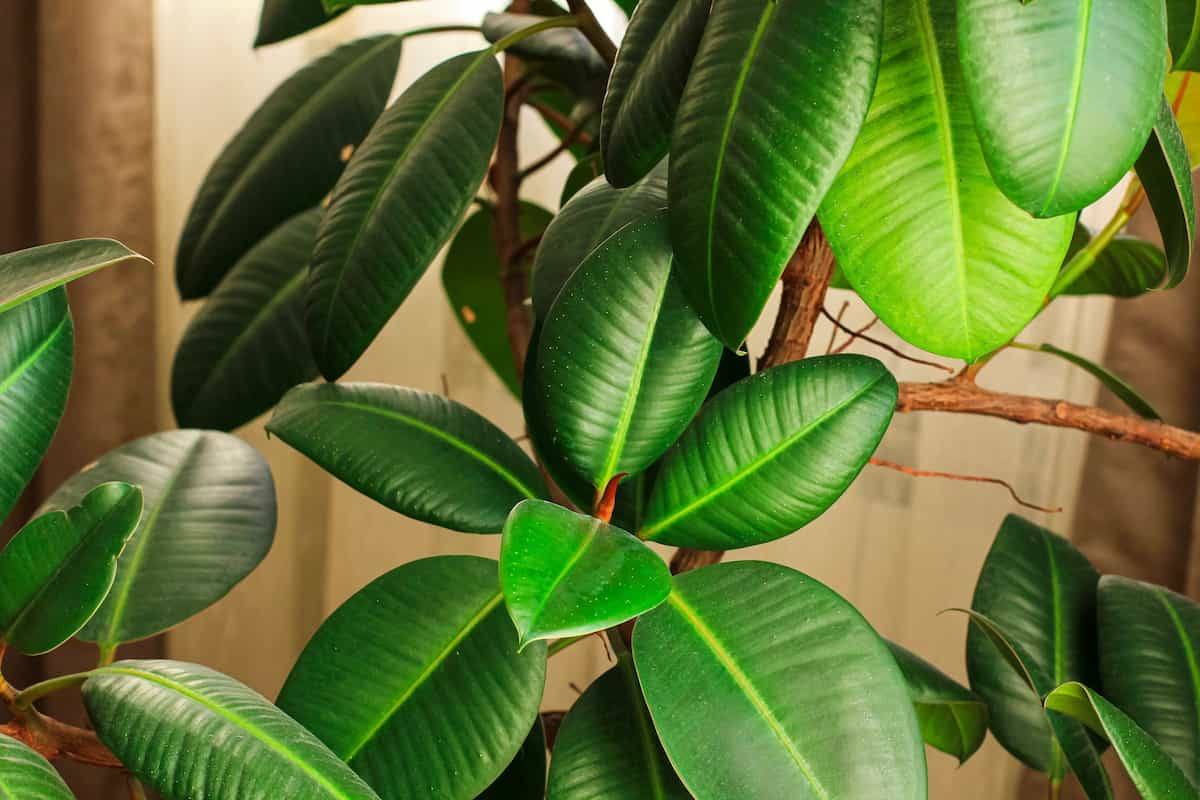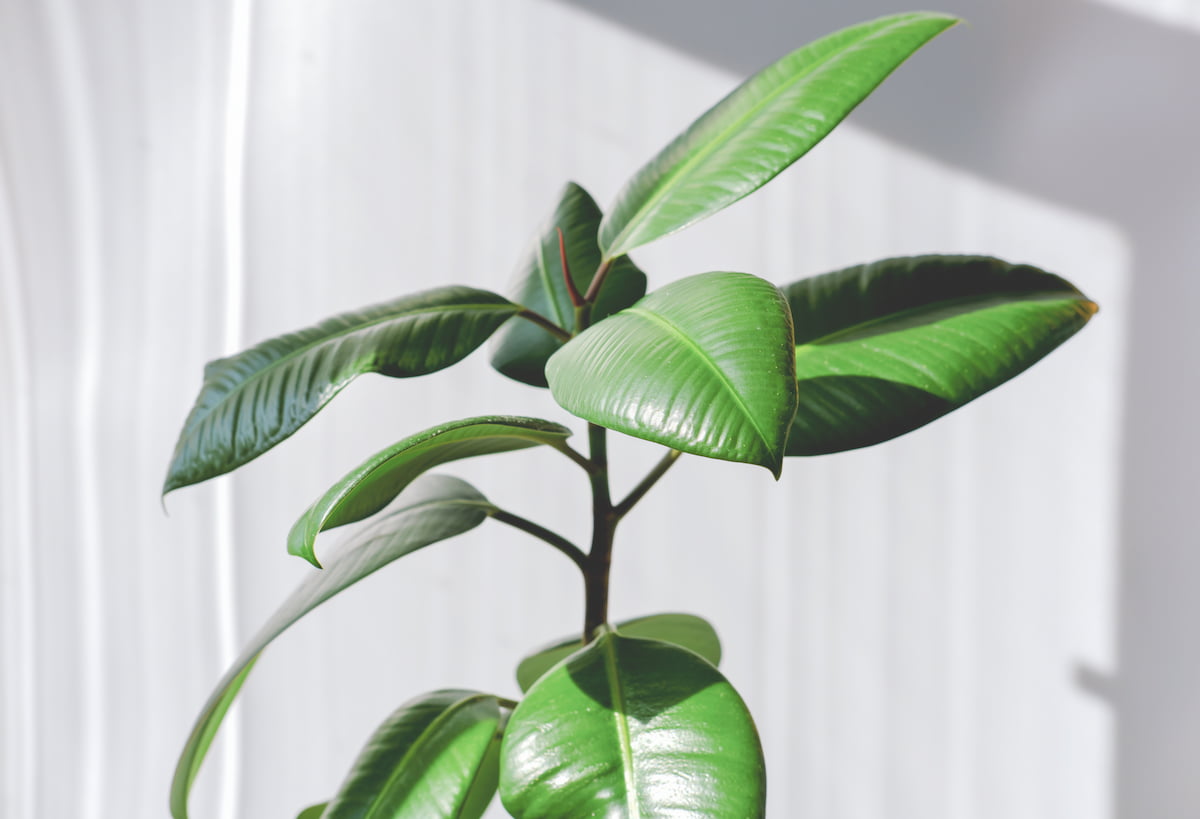Rubber trees are popular houseplants due to their lush foliage, air-purifying capabilities, and low-maintenance nature. Growing rubber trees from cuttings is an economical and straightforward way to propagate your own plants. This comprehensive guide will cover the step-by-step process of growing rubber trees from cuttings in ten simple steps. Below we learn How to grow rubber plants from cutting, how to propagate rubber plants in soil, where to cut rubber plants for propagation, and 10 simple DIY steps to growing rubber plants from cuttings.

How to Grow Rubber Plant/Tree from Cuttings
Choose the Right Cutting
Select a healthy, disease-free parent plant to ensure the success of your rubber tree cutting. Look for a stem at least 6-8 inches long with a few leaves on it. Choose a stem with a new growth tip, as it will have the most potential for rooting. Avoid stems that are too woody, as they may not root easily. Use sharp, sterilized pruning shears to minimize damage to the parent plant and prevent infection.
Prepare the Cutting
Once you have selected the ideal stem, make a clean, diagonal cut at a 45-degree angle below a leaf node. This increases the surface area available for root development. Remove the bottom two leaves to expose the leaf nodes, where roots will emerge. You can also make a small vertical cut at the base of the cutting to expose more of the cambium layer, which encourages faster rooting. To stimulate root development, dip the cut end in rooting hormone powder from most garden centers.
Select the Right Growing Medium
The choice of growing medium is crucial for successfully rooting your rubber tree cutting. A well-draining, sterile medium is essential to prevent rot and disease. You can mix equal parts peat moss and perlite or a blend of peat moss, perlite, and coarse sand. Pre-moisten the medium before planting the cutting, as it should be damp but not waterlogged. Alternatively, you can root the cutting in water, but this method may take longer and result in weaker root systems.
Plant the Cutting
Fill a small pot (4-6 inches in diameter) with the prepared growing medium, leaving about an inch of space at the top. Use a pencil or your finger to make a hole in the center, deep enough to accommodate the cut end of the cutting. Place the cutting in the hole, ensuring that the leaf nodes are in contact with the medium. Gently press the medium around the cutting to provide support and ensure good contact between the cutting and the medium.
Create a Humid Environment
Rubber tree cuttings thrive in a humid environment, as it helps maintain moisture levels and promotes root growth. To create a mini greenhouse, cover the pot with a clear plastic bag or dome, ensuring it does not touch the cutting. Place the pot in a bright, warm location with indirect sunlight. Avoid direct sunlight, as it can overheat the cutting and dry out the growing medium.
Monitor and Maintain the Cutting
Check the cutting regularly to ensure that the growing medium remains moist but not waterlogged. If the medium is drying out, mist it lightly with water, but be careful not to overwater. It is important to maintain high humidity levels by keeping the plastic cover in place. However, remove the cover briefly each day to allow fresh air to circulate, which helps prevent fungal and bacterial growth.
In case you missed it: How to Start Strawberry Farming in the USA: A Step-By-Step Production Guide

Look for Signs of Rooting
Root development typically takes 4-6 weeks, but it can take longer depending on the cutting and environmental conditions. When gently tugging on the cutting, observe the cutting for signs of rooting, such as new leaf growth or resistance. In some cases, you may see roots growing through the pot’s drainage holes. If you start cutting in water, you should see roots developing within a few weeks. Once you have confirmed that roots have formed, it’s time to transplant the cutting into a larger pot.
Transplant the Rooted Cutting
Carefully remove the cutting from its original pot, trying not to disturb the delicate new root system. Select a new pot that is slightly larger (6-8 inches in diameter) and has drainage holes. Fill the new pot with a well-draining, fertile potting mix, such as a blend of peat moss, perlite, and compost, or a commercial potting mix designed for indoor plants. Gently place the rooted cutting in the new pot, ensuring that the root ball is covered and the cutting is at the same depth as it was in the original pot.
Establish a Care Routine
Rubber trees require a consistent care routine to thrive. Place the newly transplanted cutting in a bright, warm location with indirect sunlight. Maintain a consistent watering schedule, allowing the top inch of the potting mix to dry out between waterings. Overwatering can lead to root rot, so monitoring the moisture levels in the potting mix is essential.
Fertilize the rubber tree every 4-6 weeks with a balanced, water-soluble fertilizer, following the package instructions for the appropriate dilution and application rates. Regularly inspect your plant for pests and disease, and address any issues promptly to maintain the overall health of your rubber tree.
Prune and Shape Your Rubber Tree
As your rubber tree grows, it may require pruning to maintain its desired shape and size. Use sharp, sterilized pruning shears to remove any dead, damaged, or unwanted branches, cutting just above a leaf node or a branch intersection. Regularly pinch the growing tips to encourage branching and a fuller, bushier appearance.
If your rubber tree becomes too tall, you can reduce the main stem to your desired height. Remember that rubber trees can produce a milky sap when cut or injured, so handling the plant with care is essential to avoid skin irritation.
In case you missed it: How to Grow Pumpkin from Seed in Greenhouse: A Step-By-Step Guide for Seed to Harvest

Conclusion
Growing a rubber tree from cuttings is a rewarding and straightforward DIY project allowing you to propagate your plants with minimal expense. By following these ten simple steps, you can successfully grow a healthy, thriving rubber tree that adds beauty and purifies the air in your home. Proper care makes your rubber tree a stunning focal point and long-lasting addition to your indoor garden.
- Feed Your Flock for Less: Top 10 Tips to Save on Chicken Feed
- Ultimate Guide to Ossabaw Island Hog: Breeding, Raising, Diet, and Care
- Hatching Answers: The Top 10 Reasons Your Chickens Aren’t Laying Eggs
- Eggs and Economics: Breaking Down the Cost of Raising Backyard Chickens
- Defend Your Greens: Proven Methods to Keep Iguanas Out of Your Garden
- Ultimate Guide to Cinnamon Queen Chicken: A Comprehensive Guide for Beginners
- Ultimate Guide to California Tan Chicken: Breeding, Raising, Diet, Egg-Production and Care
- Ultimate Guide to Marsh Daisy Chicken: Breeding, Raising, Diet, and Care
- 10 Types of Chicken Farming Businesses You Can Start for Profits